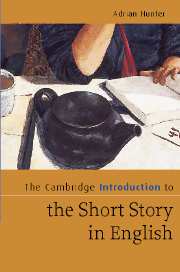Book contents
- Frontmatter
- Contents
- Acknowledgements
- Introduction
- Part I The nineteenth century
- Part II The modernist short story
- Introduction: ‘complete with missing parts’
- Chapter 4 James Joyce
- Chapter 5 Virginia Woolf
- Chapter 6 Katherine Mansfield
- Chapter 7 Samuel Beckett
- Part III Post-modernist stories
- Part IV Postcolonial and other stories
- Notes
- Guide to further reading
- Index
- Titles in this series:
Introduction: ‘complete with missing parts’
Published online by Cambridge University Press: 05 June 2012
- Frontmatter
- Contents
- Acknowledgements
- Introduction
- Part I The nineteenth century
- Part II The modernist short story
- Introduction: ‘complete with missing parts’
- Chapter 4 James Joyce
- Chapter 5 Virginia Woolf
- Chapter 6 Katherine Mansfield
- Chapter 7 Samuel Beckett
- Part III Post-modernist stories
- Part IV Postcolonial and other stories
- Notes
- Guide to further reading
- Index
- Titles in this series:
Summary
When Thomas Hardy finished reading Katherine Mansfield's story ‘The Daughters of the Late Colonel’, one day in 1921, he assumed that there would be a sequel. He didn't recognize the ending as an ending, or the story as complete in itself. He told Mansfield as much. She was bemused. ‘I put my all into that story,’ she wrote to a friend, ‘and hardly anyone saw what I was getting at … As if there was any more to say!’
Was Hardy missing something? Up to a point he was. But then so too, we might say, was Mansfield's story. Elliptical and wilfully enigmatic, ‘The Daughters of the Late Colonel’ is a superlative example of the ‘plotless’ short story, which, as we have just seen, was now firmly aligned with ‘literary’ or avant-garde writing and cultural values in Britain. Hardy's bafflement at Mansfield's interrogative, irresolute narrative was by no means unusual, and reflects the extent to which this new species of story ran against the precepts and expectations readers customarily brought to a piece of narrative fiction. Far from its origins in the popular tale-telling tradition, the short story had become, by the time Hardy died in 1928, a focus for modernist experimentation, a fixture of high-culture publishing venues and the subject of a growing body of aesthetic theory.
For many readers, the decisive moment in the short story's history is 1914, the year James Joyce published Dubliners.
- Type
- Chapter
- Information
- The Cambridge Introduction to the Short Story in English , pp. 44 - 49Publisher: Cambridge University PressPrint publication year: 2007



